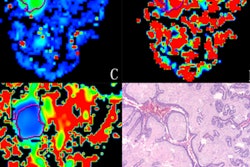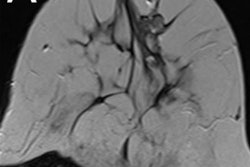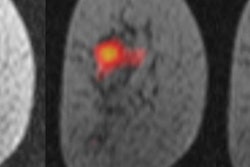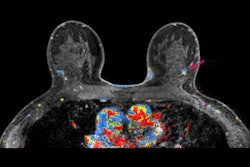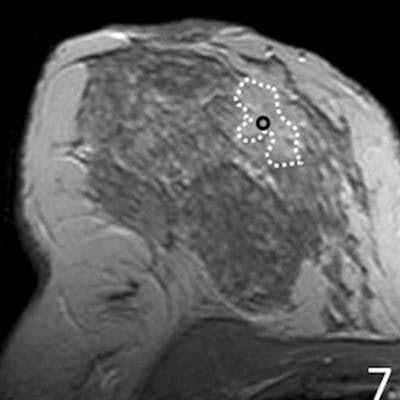
Diffusion-weighted imaging (DWI) can be used to streamline breast MRI protocols, according to a joint German-Austrian study published online on 29 July in European Radiology.
The study results are good news for women undergoing breast MRI because they could translate into shorter examinations, wrote the team led by Prof. Matthias Dietzel, a radiologist from University Hospital Erlangen in Germany.
"We ... hypothesized that DWI could be used as a substitute of [the delayed-phase enhancement part of the MRI protocol]," the group noted. "If verified, this might abbreviate and simplify current practice of breast MRI."
 Breast MRI of a 41-year-old woman with grade 2 invasive ductal cancer. Numbers denote acquisition time points of T1-weighted dynamic gradient-echo images after intravenous contrast medium injection in minutes (0 = precontrast acquisition). "1s" equals first subtraction. The dotted line delineates the lesion from the surrounding breast parenchyma. The lesion is depicted as an ill-defined mass with fast initial-phase enhancement and washout during the delayed phase. The region of interest to extract the diagnostic information used in this work is highlighted by a black circle. Images courtesy of Profs. Matthias Dietzel and Pascal Baltzer and European Radiology.
Breast MRI of a 41-year-old woman with grade 2 invasive ductal cancer. Numbers denote acquisition time points of T1-weighted dynamic gradient-echo images after intravenous contrast medium injection in minutes (0 = precontrast acquisition). "1s" equals first subtraction. The dotted line delineates the lesion from the surrounding breast parenchyma. The lesion is depicted as an ill-defined mass with fast initial-phase enhancement and washout during the delayed phase. The region of interest to extract the diagnostic information used in this work is highlighted by a black circle. Images courtesy of Profs. Matthias Dietzel and Pascal Baltzer and European Radiology.Dynamic contrast-enhanced imaging of the initial phase (IP) and delayed phase (DP) is a key part of any clinical breast MRI protocol. However, because DWI has been used increasingly as an add-on sequence, Dietzel's group sought to investigate whether it could be used instead of the delayed-phase part of the protocol.
"As the DP provides essential diagnostic information, it is considered an integral part of every standard breast MRI protocol," they wrote. "Besides morphologic and dynamic criteria, numerous additional MRI techniques have been investigated. In this context, diffusion-weighted imaging is arguably the most promising method."
But adding DWI plus the standard MRI protocol increases scanning time and exam complexity, the researchers explained. They theorized that because the delayed-phase curve type and the apparent diffusion coefficient (ADC) maps obtained from DWI are affected by extracellular space characteristics, perhaps the physiological and diagnostic information they glean would overlap -- thus allowing DWI to be used instead of the delayed-phase part of the MRI protocol.
The study included 132 patients with 145 lesions with equivocal or suspicious findings at ultrasound and/or mammography who underwent diagnostic breast MRI. Of these 145 lesions, 101 were malignant and 44 were benign. Dietzel's group, which included two researchers from the Medical University of Vienna, assessed three sections of the MRI protocol: the initial-phase enhancement, the delayed-phase enhancement, and the ADC maps obtained from DWI. The group examined mean region of interest values for the three sections, as well as the following multiparametric combinations:
- IP+: Initial-phase enhancement and DWI
- Curve: Initial-phase enhancement and delayed-phase enhancement
- Curve+: Initial-phase enhancement, delayed-phase enhancement, and DWI
They then compared the performance of these combinations based on the area under the receiver operating characteristic curve (AUC).
The IP+ combination outperformed the Curve combination, in both time needed and AUC, the group found. In addition, the Curve+ combination was not superior to the IP+ combination (p = 1).
| Performance of multiparametric combinations | |||
| Curve+ | Curve | IP+ | |
| Time | 10 minutes, 10 seconds | 7 minutes, 40 seconds | 5 minutes, 10 seconds |
| AUC | Equal to IP+ | 0.79 | 0.88 |
Based on the results, it appears the breast MRI protocol can be safely abbreviated by using DWI instead of delayed-phase enhancement, according to the group.
"As DWI is typically used as an add-on to IP and DP, our findings have a potential clinical impact," they concluded. "They provide a rationale to shorten and to simplify current breast MRI practice without losing diagnostic information."




